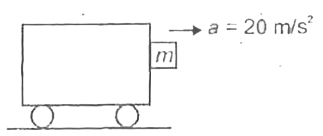From what height a block of ice must fall into a well so that of its mass may he melted )
300 m
336 m
660 m
none
The correct Answer is:B
Topper's Solved these Questions
- CALORIMETRY BOOK - AAKASH SERIESCHAPTER - CALORIMETRY EXERCISE - PRACTICE SHEET (LEVEL - II Straight Objective Type Questions)
25 Videos
- CALORIMETRY BOOK - AAKASH SERIESCHAPTER - CALORIMETRY EXERCISE - PRACTICE SHEET (LEVEL - II More than One correct Type Questions)
5 Videos
- CALORIMETRY BOOK - AAKASH SERIESCHAPTER - CALORIMETRY EXERCISE - LECTURE SHEET (Matirx Matching Type Questions)
2 Videos
- APPENDICES BOOK - AAKASH SERIESCHAPTER - APPENDICES EXERCISE - GRAVITATION (EARTH SATELLITES AND ESCAPE SPEED)
35 Videos
- CENTRE OF MASSBOOK - AAKASH SERIESCHAPTER - CENTRE OF MASSEXERCISE - ADDITIONAL PRACTICE EXERCISE (PRACTICE SHEET (ADVANCED))
3 Videos
Similar Questions
A block of ice is dropped into a well of water, both ice and water being at 0∘C. From what height must the ice fall in order that 1/100 of it may melt?
(L of ice =80×103calkg−1,J=4.2 joules cal−1 and g=9.8ms−2)
View SolutionFrom what height must a block of ice fall to just melt by the impact assuming that half of the heat generated is absorbed by ice? (J=4.2 joules per calories and L=80 kilocalories per kg)
View Solution
Knowledge Check
From what minimum height a block of ice has to be dropped in order that 0.5% of ice melts on hitting the ground ?
A171.43mB17.14mC161.43mD1.714kmA ball falls on the ground from a height of 10m and rebounds to a height of 8m. What is the percentage loss kinetic energy of the ball? (g=10m/s2)
A0.2B0.3C0.1D155An ice block at 0∘C falls from rest at certain height. If 0.1% of ice mels on reching the ground, then the height from which it is realsed (g=10m/s2,L=80cal/gm,J=4.2J/cal)
A33.6 mB336 mC3360 mD33.6 Km
From what height must a block of ice be dropped in order that it may melt completely. It is assumed that the whole of energy is retained by ice. Given that latent heat of ice =80calg−1.
View SolutionIn the above problem if m=1kg and teminal velocity attained by its is 4m/s after falling a height of 1m, the energy dissipated as heat till then is (g=10m/s2)
View SolutionA vehicle is moving on a road with an acceleration a=20m/s2 as shown in figure. The frictional coefficient between the block of mass (m) and the vehicle so that block is does not fall downward is (g=10m/s2)

View SolutionA vehicle is moving on a road with an acceleration a=20m/s2 as shown in figure. The frictional coefficient between the block of mass (m) and the vehicle so that block is does not fall downward is (g=10m/s2)

View SolutionA horizontal wire is free to slide on the verticle rails of a conducting frame as shown in figure. The wire has a mass m and length l and the resistance of the circuit is R. If a uniform magnetic field B is directed perpendicular to the frame, the terminal speed of the wire as it falls under the force of gravity is

In the above problem if m=1kg and teminal velocity attained by its is 4m/s after falling a height of 1m, the energy dissipated as heat till then is (g=10m/s2)
View Solution
